
Preview: Oakland Powers Seek 4-Peats
March 10, 2017
By Geoff Kimmerly
Second Half editor
Only one Lower Peninsula boys swimming & diving program has won at least four straight MHSAA Finals championships over the last two decades.
Birmingham Brother Rice in Division 1 and Bloomfield Hills Cranbrook Kingswood in Division 3 have the opportunity this weekend to join the Saline teams from 2010-13 in building such a remarkable streak.
Both the Warriors and Cranes are going for their fourth straight MHSAA titles as action begins both Friday (preliminaries) and Saturday at noon at three sites. See below for team favorites and top individuals to watch at all three meets.
All three Finals also will be streamed live and can be watched with subscription on MHSAA.TV. Click for lineups and seed times for all three meets and below for direct links to broadcasts of all three meets.
Division 1 - Division 2 - Division 3
LP Division 1 at Oakland University
Top-ranked Birmingham Brother Rice has won the last three Division 1 titles, but this isn’t necessarily a one-team race. The Warriors have two top seeds, but only 13 other entries seeded to score among the top 16. Second-ranked Skyline, the 2015 runner-up in Division 2, is seeking its first championship and has 17 top-16 seeds and a strong diver. Saline and Novi tied for third in the final state ranking and should be in the mix, Saline with 12 seeded to score and Novi with 14 and a diver.
Spencer Carl, Holland West Ottawa senior – The reigning champion in the butterfly and 200-yard freestyle is expected to close his career with at least one more title; he’s seeded first in the 200 (1:39.77) and second in the 500 (4:37.67.) and is expected to swim on two top-five seeded relays.
Jonathan Lee, Detroit Catholic Central junior – He moved up from 13th in the breaststroke as a freshman to fourth last season and also took sixth in the individual medley; he’s seeded only ninth in the IM (1:56.43) but first in the breaststroke (56.54).
Alex Margherio, Birmingham Brother Rice junior – Margherio was part of Finals champions last season in the 200 medley and 400 freestyle relays, and he also took second in the butterfly and third in the backstroke. Both relays are seeded among the top five and the medley (1:33.26) has the top seed, and individually Margherio is seeded second in the butterfly (50.17) and first in the backstroke (50.97).
Camden Murphy, Novi senior – One of the most highly-regarded swimmers his age in the country, Murphy decided to swim for his high school team as a senior and has the top seed time in the IM (1:49.10) by nearly three seconds and the top butterfly seed time (47.94) by more than two; his butterfly time would break the LP Division 1 Finals record and approach the all-Finals record of 47.51. He could also swim on any of three top-five relays.
Benjamin Rojewski, Livonia Stevenson sophomore – He placed seventh in the 500 last season as a freshman, but carries the top seed in that race (4:36.49) by more than a second and is seeded fifth in the 200 freestyle (1:42.94).
Henry Schutte, Grand Rapids Forest Hills Central sophomore – He took second in both the 50 and 100 freestyles last season as a freshman, and enters this weekend with the top 50 seed (20.87) and third-fastest in the 100 (46.36).
Gabriel Trevino, Zeeland senior –
After taking fifth in the 50 and 100 last season as a junior, he’s seeded second in the 50 (20.95) and first in the 100 (46.09) and could also swim on any of three qualified relays.
LP Division 2 at Eastern Michigan University
Top-ranked Ann Arbor Huron has four MHSAA titles during a highly-regarded history, but is seeking its first since winning Division 1 in 2008. The River Rats were 10th in Division 1 last season and have 12 individuals and all three relays seeded to score. Dexter is the reigning champion and has won this division two of the last five seasons; it also has 12 individuals and all three relays in scoring position. Groves is tied with Dexter for the No. 2 ranking and finished fifth a year ago. It has 11 individual seeds among the top 16 and also all three relays in position to score, plus a diver competing.
Alexander Capizzo, Fraser freshman – At his first Finals, Capizzo enters with the fastest seed in the 500 (4:32.05) by more than three seconds and third-fastest in the IM (1:55.80).
Niklas Eberly, Dexter sophomore – After finishing 16th in the 200 freestyle and seventh in the 500 last season for Pinckney, he enters this weekend seeded first in the butterfly (51.32) and sixth in the 200 freestyle (1:45.11) and potentially part of any of three top-six relays.
Noah Frassrand, Ann Arbor Huron senior – He finished seventh in the IM and 10th in the breaststroke in Division 1 last season for Ann Arbor Pioneer, and enters this Division 2 Finals fourth in the breaststroke (59.01) and top-seeded in the IM (1:54.43) and as part of two top-seven relays.
Jacob Krzciok, Midland Dow junior – He’s back after finishing 10th in the 100 freestyle and swimming on three top-nine relays in 2016, and he’ll have a chance to contribute even more seeded first in the 50 (20.89) and second in the 100 (46.51) while possibly swimming on any of three top-11 relays.
Ryan Lawrence, Birmingham Seaholm senior – He was part of championship 200 and 400 freestyle relays last season and also took second in the 100 freestyle and 10th in the backstroke. This weekend, he’s seeded second in the 50 (21.14), first in the 100 free (46.49) and those two relays also are seeded first at 1:27.49 and 3:13.24, respectively.
Zach Milke, Warren DeLaSalle junior – In addition to finishing third in the backstroke and eighth in the IM last season, Milke was part of the champion medley relay and third-place 400 relay. He’s seeded third in the 50 (21.23) and first in the backstroke (50.88) this time, and that medley relay (1:36.74) is seeded first while the 400 is seeded second (3:13.53).
Graham Miotke, Rochester Adams junior – The reigning champion in the 500 also took fourth in the 200 last season and finds himself seeded second in both races with a 1:43.41 in the 200 and 4:35.29 in the 500.
Patrick Seidel, Birmingham Groves junior – He’s expected to take another jump after finishing sixth in the breaststroke and 11th in the IM last season; he’s seeded first in the breaststroke (58.78) and sixth in the IM (1:58.48) and could swim on two top-seven relays.
David Turner, Pinckney senior – He’s looking at a strong finish to his career after taking ninth in the 200 freestyle and 11th in the 100 last winter. Turner is seeded first in the 200 (1:43.34) and third in the 100 (46.89).
LP Division 3 at Holland Aquatic Center
After trailing East Grand Rapids in the first three state rankings this season, Bloomfield Hills Cranbrook Kingswood grabbed a tie for the top spot with the Pioneers in the final listing as the Cranes go for a fourth straight championship. They have all three relays and 14 individuals with top-16 seeds. East Grand Rapids, last season’s runner-up, has only three relays and nine individual entries seeded to score, but also the reigning diving champion and another contender in that event. Chelsea finished runner-up in both 2014 and 2015 and has three relays and 11 individual entries among the top 16 seeds in those events, including three top seeds and two second seeds.
Rudy Aguilar, Pontiac Notre Dame Prep senior – He’s looking to add to the relay championship he won for Brother Rice as a sophomore, and is favored as the top seed in the 100 freestyle (45.71) and 200 freestyle (1:39.93). He finished second in the 100 and fourth in the backstroke for Notre Dame Prep last season.
Christian Bart, East Grand Rapids junior – He added a championship in the IM and runner-up finish in the breaststroke to two second places as a freshman; this weekend he’s seeded first in the breaststroke (57.17) and second in the 50 (21.18) with spots on two top-seven relays as well.
Skyler Cook-Weeks, Holland Christian junior – Cook-Weeks made good on his top seed in the 500 last season with the title and finished second in the 200 as well; he’s seeded first in the 500 again (4:33.98) and second to Aguilar in the 200 (1:40.67) while swimming on possibly any of three top-six relays. The 400 freestyle relay is seeded first (3:10.63) by nearly a second.
Joey Mangner, Chelsea senior – The 2015 champion in the 50 false-started in the Final last season but did finish fourth in the 100 and anchored the champion medley relay. He’s seeded first in the 50 (20.78) with a time that would tie the meet record, and second to Aguilar in the 100 (46.50) while possibly swimming on the top-seeded 200 freestyle (1:26.86), second-seeded 400 freestyle (3:11.41) or top-seeded medley (1:35.59) relays.
Luke Mason, Holland Christian junior – He enters this weekend seeded second to Cook-Weeks in the 500 (4:44.17) and first in the IM (1:56.26) and potentially could swim on any of three top-six relays as well.
Ben Puglessi, Grand Rapids Catholic Central junior – After finishing seventh in the 200 freestyle and 10th in the backstroke as a sophomore, Puglessi enters as the third seed in the 200 (1:44.73) and second in the butterfly (51.29).
Riley VanMeter, Holland Christian sophomore – VanMeter carries the top seed in the butterfly (51.15) and backstroke (52.65) into this Finals and likely will swim on at least one of those highly-seeded relays as well.
Grant Williams, East Grand Rapids senior – After jumping from 16th in diving as a sophomore to win the championship last winter, he enters this weekend after finishing second at his Regional (448.85) 10.5 points back of Hamilton senior Nolan DeJonge.
PHOTO: Swimmers launch last season at the start of the 400-yard freestyle relay at the LP Division 3 Finals. (Click to see more from HighSchoolSportsScene.com.)
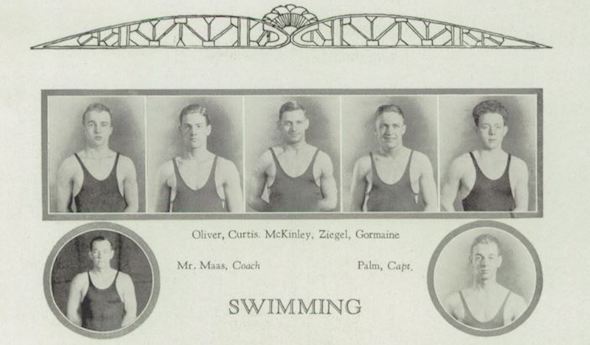
Michigan Boys Take the Swimming Plunge
November 30, 2018
By Ron Pesch
Special for Second Half
It was late March. Dressed in his black silk swimsuit adorned with an orange letter “J,” James Dingman stood 18 inches above the waterline, perched on a spring-less board. In 60 seconds it would be over.
With his arms outstretched into an inverted “V,” he dove face first into the 90-foot swimming pool. The tank, 30 feet wide, and located on the campus of Michigan Agricultural College (now Michigan State University), was the largest of its kind in the Midwest and measured 15 feet longer than a standard competitive pool.
“The aim of all plungers should be to leap as high into the air as possible and as far out as an open jack-knife will carry,” wrote Tom J. Clemens in the 1919-20 edition of the Wilson Athletic Library Official Swimming Guide, the bible of instruction and rules for swimming, diving, water games and lifesaving. “Nearly all plungers dive too flatly,” added the coach of the Detroit Y.M.C.A. swimming team. “A plunge is only as good as the dive.”
How long Dingman remained under water or at what distance he surfaced is not recorded. According to Clemens, a dive might bring the body to within six inches of the bottom of the pool. The best plungers remain under water as long as possible, angling upward at 40 degrees just as the force of the dive is spent. Record holders would surface 40 to 50 feet out into the water.
Upon surfacing, as per the rules of the event, Dingman glided along the surface, without the aid of propulsion from his arms or legs, for a measured distance of 63 feet. The mark fell two feet short of his performance in the prelims. Still, it was the best of the day and earned him a first place finish at the 1925 team state swimming championships.
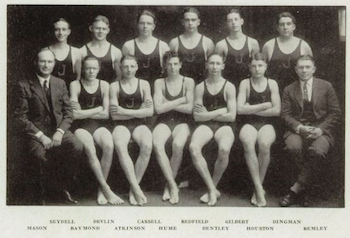 While its origins are unclear, the plunge for distance dates back to at least 1865. In 1904, it appeared as an Olympic diving event, and then disappeared from the games. By the 1920s, it was rapidly losing popularity. The plunge appeared only twice in the Michigan high school state title meets. The first time was in 1924 in what was Michigan’s first swimming and diving championships. Sanctioned by the Michigan Interscholastic Athletic Association (MIAA), the immediate predecessor to the modern-day Michigan High School Athletic Association (MHSAA), a total of nine teams – Northern, Northwestern and Southeastern, all of Detroit; Highland Park, Ann Arbor, Jackson, Lansing, Battle Creek Lakeview and Flint Central – took part in the event.
While its origins are unclear, the plunge for distance dates back to at least 1865. In 1904, it appeared as an Olympic diving event, and then disappeared from the games. By the 1920s, it was rapidly losing popularity. The plunge appeared only twice in the Michigan high school state title meets. The first time was in 1924 in what was Michigan’s first swimming and diving championships. Sanctioned by the Michigan Interscholastic Athletic Association (MIAA), the immediate predecessor to the modern-day Michigan High School Athletic Association (MHSAA), a total of nine teams – Northern, Northwestern and Southeastern, all of Detroit; Highland Park, Ann Arbor, Jackson, Lansing, Battle Creek Lakeview and Flint Central – took part in the event.
The 1925 championships was the first run by the MHSAA. Also staged at the M.A.C. pool, it featured a 10th team – Detroit Cass Tech. Dingman’s performance, combined with teammate Dick Seydell’s surprising first-place finish in the fancy diving competition and Jack Redfield’s second in the 100-yard freestyle, helped Jackson High School earn an unexpected runner-up finish in only its second year of competition.
Following the actions of the NCAA, the state association removed the plunge from the schedule of competition prior the 1926 championship meet.
Fancy diving and my plunge into uncharted waters
My ‘job” as MHSAA historian, (which is really just a fascination with prep sports history) has always been to fill in holes that surface when I, the various members of the MHSAA staff or the state’s television, radio or newspaper media, seek answers to a question. I’m a detail guy, who earned my living as a business analyst compiling, normalizing and studying data. I love diving deeper into information, completing lists and unearthing stories to tell.
From the first trophy awarded by the MHSAA in 1925, and then for the next 20 years, the state’s 35 team swimming championships never strayed beyond the borders of four Michigan counties: Wayne, Washtenaw, Calhoun and Jackson. Two of those counties, Washtenaw and Calhoun, accounted for 24 of those 35 titles.
Within those borders, only eight schools claimed titles during those two decades, with two schools combining for 18 of those awarded championships.
Detroit dominates
The Detroit area dominated statewide competition in the earliest days. The metro area boasted many of the state’s finest high schools, offering students, male and female, a wide array of athletic facilities and opportunities. During the 1920s, the schools dominated across a variety of sports, including swimming where Detroit Northwestern, Detroit Northern and Highland Park battled for annual city, state and, often, mid-west supremacy.
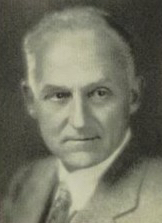 From 1925-1927, Detroit Northwestern, coached by Bert Maris, won the MHSAA’s Open Class swimming competitions, featuring all schools regardless of enrollment. A former coach at University of Michigan and Notre Dame, Maris accepted the position of athletic director at the newly-opened Northwestern High School in 1914, and stayed for 28 seasons before retiring in 1942. Like many mentors from the era, he coached multiple sports, winning state titles in basketball, track, and swimming. Over the years he worked with an amazing number of athletes, including football legend Knute Rockne and track stars Eddie Tolan and Willis Ward. Maris’ teams actually won four swimming titles in a row, as Northwestern topped Jackson in that 1924 MIAA prep championship. That meet featured eight events. Besides the plunge, and fancy diving, it included the 50, 100 and 220-yard freestyles, the 50-yard breaststroke, the 50-yard backstroke, and the 120-yard relay.
From 1925-1927, Detroit Northwestern, coached by Bert Maris, won the MHSAA’s Open Class swimming competitions, featuring all schools regardless of enrollment. A former coach at University of Michigan and Notre Dame, Maris accepted the position of athletic director at the newly-opened Northwestern High School in 1914, and stayed for 28 seasons before retiring in 1942. Like many mentors from the era, he coached multiple sports, winning state titles in basketball, track, and swimming. Over the years he worked with an amazing number of athletes, including football legend Knute Rockne and track stars Eddie Tolan and Willis Ward. Maris’ teams actually won four swimming titles in a row, as Northwestern topped Jackson in that 1924 MIAA prep championship. That meet featured eight events. Besides the plunge, and fancy diving, it included the 50, 100 and 220-yard freestyles, the 50-yard breaststroke, the 50-yard backstroke, and the 120-yard relay.
The 1925 meet, in which Dingman competed, included the same events and added the 300-yard medley relay, comprised of the 60-yard backstroke, 60-yard freestyle, 60-yard breaststroke and 120-yard free. While Northwestern repeated as team champion, Gurdon Guile of Flint Central “was the star of the meet, with a first in the 100-yard freestyle and a second in the 50-yard freestyle.”
OPEN CLASS
|
Year |
Champion (Coach) |
Runner-Up |
|
1925 |
Detroit Northwestern (Bert Maris) |
Jackson |
|
1926 |
Detroit Northwestern (Bert Maris) |
Highland Park |
|
1927 |
Detroit Northwestern (Bert Maris) |
Highland Park |
|
1928 |
Highland Park (Grant Withey) |
Detroit Northern |
The 1926 championships featured 10 Michigan high schools, including Belding, a newcomer to state swimming circles. Horace Craig, later a star swimmer at Michigan State, trimmed eight seconds from the 220 freestyle record in leading Northwestern to its third straight title in 1926. He again topped the mark in the preliminaries in 1927 as Northwestern posted 57 points, outdistancing runner-up Highland Park by 34.
In 1928, Highland Park jumped to the forefront, qualifying 10 of 26 swimmers in preliminary competition – more than twice the number of any other school – then unseated the four-time champions in the finals to win the competition. The Polar Bears topped six state meet records (including Craig’s 220 freestyle mark) along the way. Then, led by Louis Lemak and Bob Klintworth, future swimmers at the University of Michigan, Highland Park repeated as champion in 1929 when MHSAA competition was split into Class A for the state’s largest schools based on enrollment and Class B-C-D to handle all other schools with swim programs in the state. Roosevelt High, one of two high schools in Ypsilanti, grabbed the Class B-C-D crown, with East Grand Rapids finishing second.
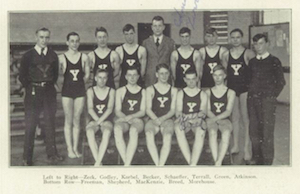 In the spring of 1930, Central High School in Ypsilanti eked past East Grand Rapids by a single point to top a field of seven schools competing for Class B-C-D honors. It was the first of four straight titles for Ypsilanti Central and their coach, James Schaffer, over a five-year span. (In 1932, the Indians finished runners-up to River Rouge. Rouge, in turn, finished second to Ypsilanti in 1931, 1933 and 1934).
In the spring of 1930, Central High School in Ypsilanti eked past East Grand Rapids by a single point to top a field of seven schools competing for Class B-C-D honors. It was the first of four straight titles for Ypsilanti Central and their coach, James Schaffer, over a five-year span. (In 1932, the Indians finished runners-up to River Rouge. Rouge, in turn, finished second to Ypsilanti in 1931, 1933 and 1934).
Detroit Northwestern returned to the pedestal in 1930, earning another title against a field of 14, this time with Leo S. Maas as coach. It would be the last swimming title awarded to a Detroit Public League school.
With the arrival of the 1930-31 school year, Detroit public schools withdrew from state interscholastic competition, to focus only on intramural contests between other Detroit city schools. Vaughn S. Blanchard, who took charge as Director of Health and Physical Education for the Detroit Public Schools in 1929, cited in the decision his belief that there was an unhealthy overemphasis on competitive athletics. The voluntary exile would last for the next 30 years and recast competition within Michigan prep athletics.
Maas’ teams would continue to dominate Detroit swimming, winning 7 of 9 City League championships. In September of 1938, he joined the staff of Wayne University as swimming coach, leading the Tartars to national prominence in the 1940s. He spent 20 years at the school, renamed Wayne State University in 1956.
Battle Creek Takes Charge
Charles McCaffree, Jr. was born in South Dakota and learned to love swimming at the YMCA pool in Sioux City. He followed his brother to the University of Michigan, earning three varsity letters under internationally-known swimming coach Matt Mann. Following college graduation in 1930, McCaffree was hired at Battle Creek Central as swimming coach in 1931. For the next six years, 1931-1936, his Bearcats teams won Michigan swimming titles. All were in Class A, with the exception of the 1935 tournament, when, because of the Great Depression, only a single title was awarded. A total of 139 swimmers from 14 teams competed in the state’s 12th annual meet, held at the intramural pool at the University of Michigan.
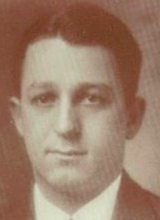 The MHSAA returned to two class championships in the spring of 1936. Ypsilanti Roosevelt returned to the winners’ circle, besting Ypsilanti Central by two points, 38 to 36, while winning four first places in the eight-event meet.
The MHSAA returned to two class championships in the spring of 1936. Ypsilanti Roosevelt returned to the winners’ circle, besting Ypsilanti Central by two points, 38 to 36, while winning four first places in the eight-event meet.
In September 1936, McCaffree returned to U-M to take over the Wolverines program while Coach Mann attended to his seriously ill father in Leeds, England. McCaffree’s teams at Battle Creek had won 53 dual meets and lost only three. He helped build the district’s junior high swim program and turned out 14 prep All-Americans, (including Dobson “Dobbie” Burton, captain of Michigan’s 1941 NCAA championship swim team and later, a very successful swim coach at Evanston Township High School in Illinois). With Mann’s return to the helm at Michigan in February 1937, McCaffree accepted the head swimming coaching position at Iowa State, where his teams won four Big Eight Conference Championships.
In 1942, “Coach Mac” was hired by Michigan State athletic director Ralph Young to head the Spartans swim team. For the next 28 years, he guided the team as head coach, winning eight straight Central Collegiate Conference championships prior to State’s entry into the Big Ten. In 1957, he led MSU to its first Big Ten swimming title. Before retiring as coach in 1969, “his student-athletes earned All-American honors 322 times, won 34 Big Ten titles, and claimed 22 NCAA titles. Six individuals qualified for the Olympics.” In 1979, the university named the pools within the Intramural-West Building in his honor.
CLASS A
|
Year |
Champion (Coach) |
Runner-Up |
|
1929 |
Highland Park (Grant Withey) |
Detroit Northern |
|
1930 |
Detroit Northwestern (Leo. S. Maas) |
Detroit Northern |
|
1931 |
Battle Creek Central (Charles McCaffree) |
Lansing Central |
|
1932 |
Battle Creek Central (Charles McCaffree) |
Kalamazoo Central |
|
1933 |
Battle Creek Central (Charles McCaffree) |
Lansing Central |
|
1934 |
Battle Creek Central (Charles McCaffree) |
Lansing Central |
OPEN CLASS
|
Year |
Champion (Coach) |
Runner-Up |
|
1935 |
Battle Creek Central (Charles McCaffree) |
Dearborn Fordson |
CLASS B-C-D
|
Year |
Champion (Coach) |
Runner-Up |
|
1929 |
Ypsilanti Roosevelt (Howard Farnslow) |
East Grand Rapids |
|
1930 |
Ypsilanti (James Schaffer) |
East Grand Rapids |
|
1931 |
Ypsilanti (James Schaffer) |
River Rouge |
|
1932 |
River Rouge (Benny Goodell) |
Ypsilanti |
|
1933 |
Ypsilanti (James Schaffer) |
River Rouge |
|
1934 |
Ypsilanti (James Schaffer) |
River Rouge |
Ypsilanti, Jackson emerge
McCaffree’s replacement at Battle Creek, John Vydareny, led the Bearcats to a seventh consecutive title in 1937. The city of Ypsilanti retained control of the Class-B-C-D title, as Ypsilanti Central dethroned Roosevelt High 71-54. It was the first of three consecutive by Central High and coach James Schaffer.
“More than 200 high school swimming stars churned the Michigan State college pool today as they warmed up for trials in the 15th annual Michigan High School Athletic association championship swim,” noted The Associated Press in 1938 pre-event coverage.
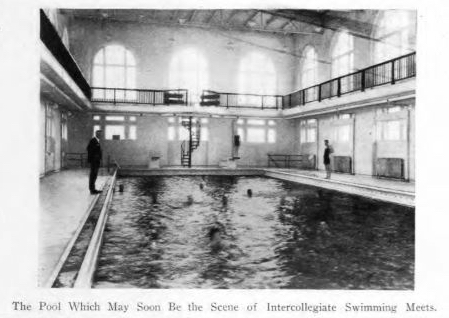 A broadcast, featuring a running account of the meet, was recorded in East Lansing that Saturday and brought to Battle Creek for an 11:00 p.m. broadcast on radio station WELL-AM. Designed to give listeners “the pool’s edge atmosphere of the meet,” the program was replayed on Sunday evening “to give those who did not attend, and those who retired too early to hear the Saturday night program.”
A broadcast, featuring a running account of the meet, was recorded in East Lansing that Saturday and brought to Battle Creek for an 11:00 p.m. broadcast on radio station WELL-AM. Designed to give listeners “the pool’s edge atmosphere of the meet,” the program was replayed on Sunday evening “to give those who did not attend, and those who retired too early to hear the Saturday night program.”
Jackson, which lost the Five-A league title to Battle Creek, emerged as the Class A winner. Both schools brought 22 to the event.
“Jackson dethroned the Bearcats…in the Michigan State college natatorium and the difference between an eighth successive crown and runner-up position … was disqualification of the Battle Creek Medley relay team in the preliminaries. The Bearcat medley trio finished a full half lap in front of the field … in record time … but it was ruled out …”
Jackson finished with 39 points, followed by Battle Creek with 32. The Vikings would repeat as Class A champions in both 1939 and 1940. Coach Elwood Watson’s swimmers would pick up a fourth title in 1942. Battle Creek Central added three additional titles to their total with wins in 1941, 1943 and 1944. Because of World War II restrictions, only 13 schools entered the Class A meet and five competed in Class B-C-D in 1943, while 14 schools participated in the Class A meet in 1944 at Michigan State, and six schools chased honors in the Class B-C-D competition at the University of Michigan.
With the absence of Detroit schools during the 14-year span, 1931 through 1944, a member of the 5-A League – comprised of Battle Creek, Jackson, Ann Arbor, Lansing Eastern and Lansing Central – controlled Michigan’s Class A swim title during that time. On nine occasions during that period, the 5-A also placed the state runner-up.
I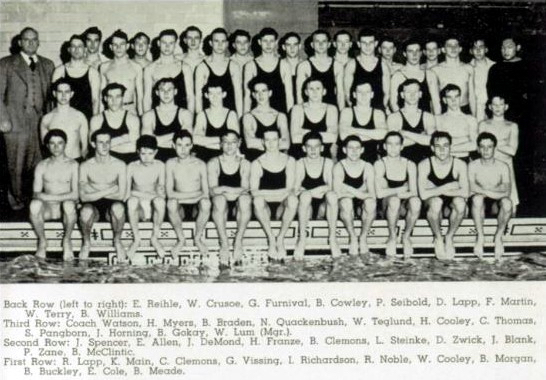 n Class B-C-D, Ann Arbor University High emerged as a swimming power, finishing as runner-up to Ypsilanti Central in both 1938 and 1939. Guided by University of Michigan assistant swimming coach Harvey Muller, the Cubs ended the city of Ypsilanti’s grip on the smaller school title in 1940.
n Class B-C-D, Ann Arbor University High emerged as a swimming power, finishing as runner-up to Ypsilanti Central in both 1938 and 1939. Guided by University of Michigan assistant swimming coach Harvey Muller, the Cubs ended the city of Ypsilanti’s grip on the smaller school title in 1940.
“University High’s crack free-style quartet of Bill Koch, Earl Bryant, Jim Gordy and Max Tobias nosed out Central in the final relay to overcome a 43-42 lead which Ypsilanti held prior to the event.”
With the win, “the Ann Arbor tankers scored 52 points, one more than Central … It was Central’s first defeat in the state meet in the last four years.”
Ypsilanti Central topped Roosevelt in the 1941 state meet, this time under the guidance of coach Christy Wilson. University High won the first of five straight titles, with Muller as coach in 1942 and the legendary Matt Mann guiding the team from 1943 to 1946. Among the winners in 1943 was Matt Mann, Jr., who clipped five seconds off the meet’s 200-yard freestyle record. He would later be named a four-time All-American at Michigan and compete on the university’s 1948 national championship swim team. Following graduation, Mann, Jr. coached swimming and diving at Lansing Sexton High School.
Times Change
Post World War II saw many changes to society, cities, and, within competitive swimming, new record setters and coaching legends emerged. In 1980, a separate boys tournament was added to the MHSAA menu for Michigan’s Upper Peninsula. The grouping of schools moved from classes to divisions in 2003, and in 2008, a third division was added.
Today, ownership of MHSAA boys swimming & diving titles has geographically traveled a bit farther, but still to only 12 of Michigan’s 68 Lower Peninsula counties.
 Ron Pesch has taken an active role in researching the history of MHSAA events since 1985 and began writing for MHSAA Finals programs in 1986, adding additional features and "flashbacks" in 1992. He inherited the title of MHSAA historian from the late Dick Kishpaugh following the 1993-94 school year, and resides in Muskegon. Contact him at [email protected] with ideas for historical articles.
Ron Pesch has taken an active role in researching the history of MHSAA events since 1985 and began writing for MHSAA Finals programs in 1986, adding additional features and "flashbacks" in 1992. He inherited the title of MHSAA historian from the late Dick Kishpaugh following the 1993-94 school year, and resides in Muskegon. Contact him at [email protected] with ideas for historical articles.
PHOTOS: (Top) The 1930 Detroit Northwestern team was among early state swimming powers. (2) Jackson's 1925 team also was an early force in the sport. (3) Bert Maris. (4) The 1930 Ypsilanti team. (5) Charles McCaffree, Jr. (6) The Michigan Agricultural College pool, in 1921. (7) The 1940 Jackson team. (Photos collected by Ron Pesch.)

